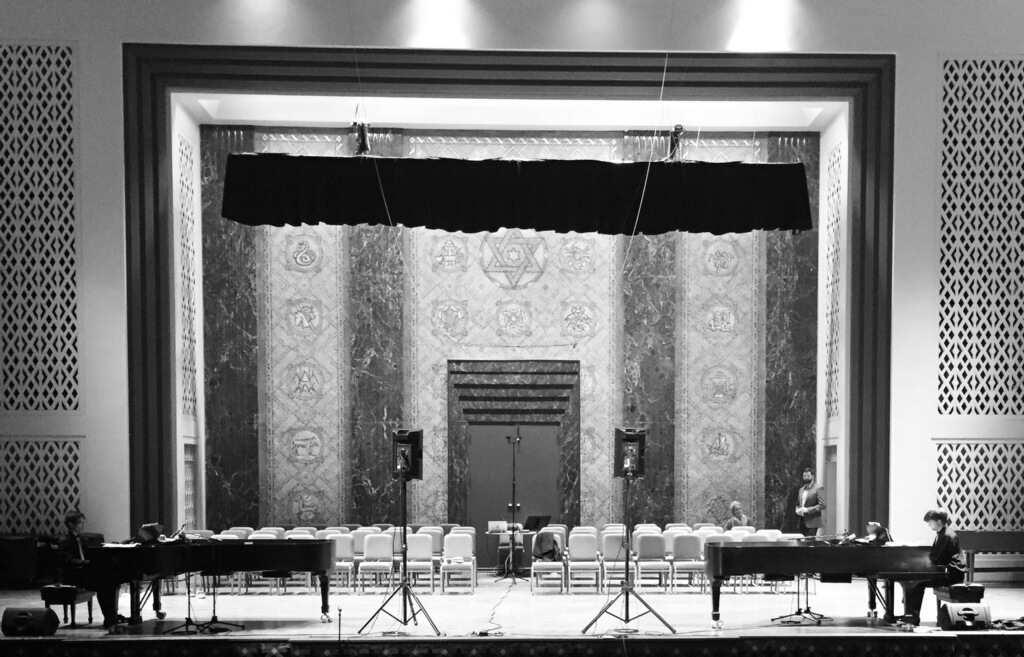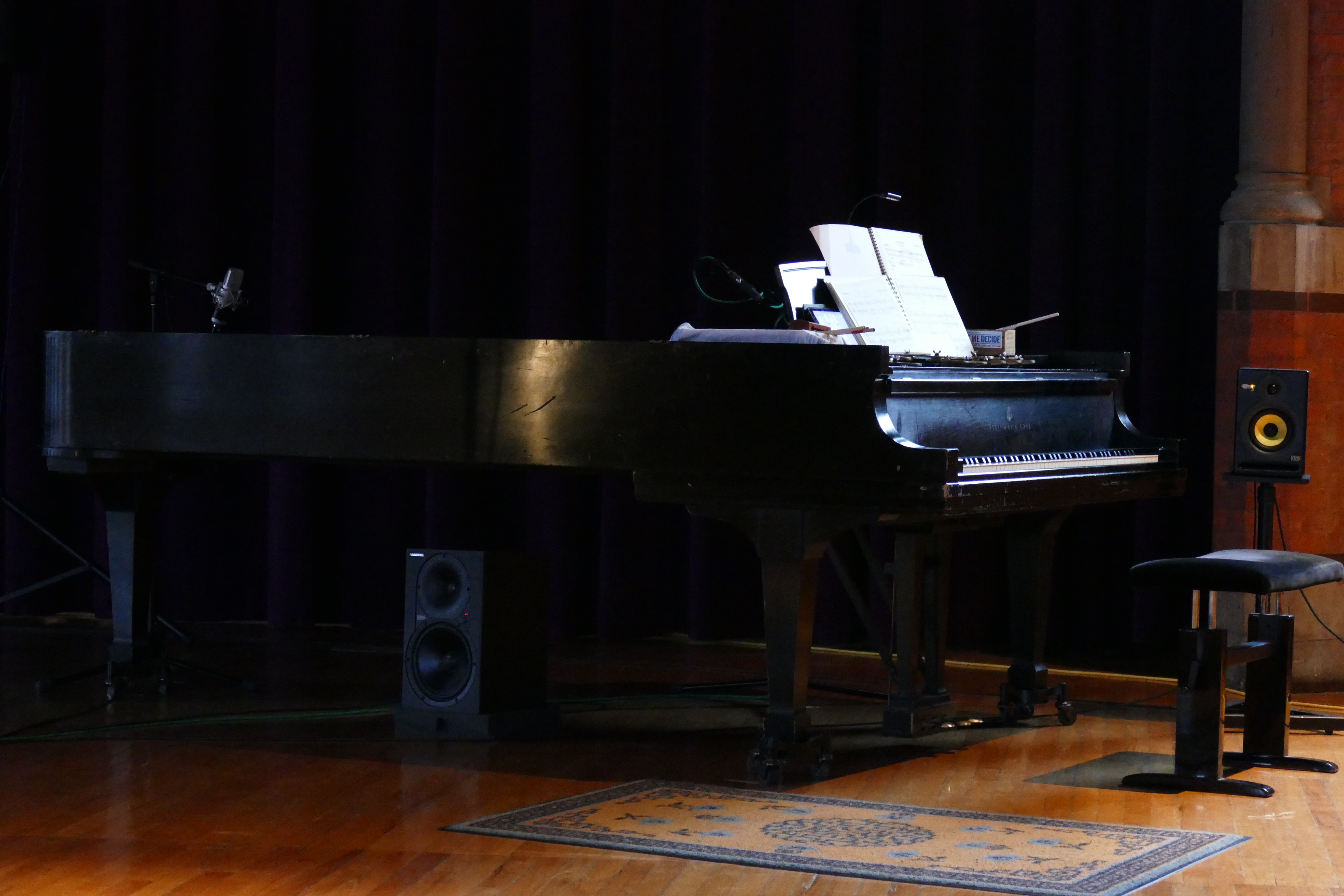All of this started back in 2015 when one of us had the bright idea to play MANTRA (it is customary to capitalize Stockhausen’s titles). Call it peer pressure, momentary madness, mutual self-delusion… these are the ingredients for any exciting musical project, and any work of Stockhausen’s demands a willingness to embrace his inescapable drive to reinvent the wheel.
While it is difficult to make grandiose statements about Stockhausen’s output as a whole (more grandiose than the music itself, anyway––every piece is a world unto itself), MANTRA occupies an intriguing position in Stockhausen’s compositional development. His works from the 1950s demonstrate his thorough preoccupation with serial techniques, KREUZSPIEL and the early Klavierstücke among his most important instrumental works from this period, and GESANGE DER JÜNGLINGE and KONTAKTE touchstones in the development of electronic and electro-acoustic music. With KONTAKTE he takes a clear turn into so-called “moment form,” where the strong characterization of singularly distinct musical moments takes precedence over the atomically crystalized overarching formal structures of serial composition. Moments strung together as a kind of mosaic leads to freer, almost improvisatory structures (as in MIKROPHONIE I), culminating in the almost infamous text pieces from the late 1960s, AUS DEN SIEBEN TAGEN (“From the Seven Days”), such as this movement, VERBINDUNG (“Connection”):
MANTRA, composed in 1970, is often seen as the beginning of Stockhausen’s compositional thinking that would lead to an extraordinary 26 year long operatic project, LICHT: seven operas, each named for a day of the week, about the allegorical balance of natural and supernatural forces in the universe as portrayed by EVA, MICHAEL, and LUZIFER. A “super-formel,” or over-arching formula (seen here on his incredible headstone in Kürten), determines absolutely every musical element occurring at every structural level of every single opera across this 26 year span: an heirloom of Wagner’s influence, ‘exploded’ (structurally and spiritually) to the width of a galaxy, and then some. MANTRA was his first exploration of this idea, and similarly ‘explodes’ its opening 12-tone melody (the “mantra”) and its characterizing articulations and dynamics across a 70-minute canvas, each section of the piece based around a moment in the opening melody. Ring modulation, the electronic process of essentially ‘refracting’ sound through the clinical prism of a sine wave, allows the piece to explore the foundations of tonality itself, each section refracted through a different pitch from the opening melody. The result is a timeless, near-operatic exploration of musical space––a spiritual reverence of sound itself, at times irreverent of its own structural foundations and even the pianists themselves, who at one point ‘break’ the piece and start yelling at each other, a kind of bizarre musical joke tucked inside a ritualistic, Noh-inspired dramatic machination.
Our work on MANTRA has been an awe-inspiring experience, but we began to feel that its significance as a musical-historical object could not truly be measured without a connection to the present. We have been very fortunate to enlist the interest of several wonderful composers of our generation, daring enough to pay homage to Stockhausen’s tome to pianistic exploration, while squarely occupying their own carefully honed aesthetic spaces––in 2017 we received our first piece, Foreword, by Christopher Stark, who has at times has served as our very capable sound diffusionist (Chris also initiated Ryan, who developed the electronics for our version of MANTRA, into the world of electroacoustic techniques, and as such is at least partly responsible for this project); later in 2017 we were lucky enough to succeed at a Fromm Foundation commissioning grant for a new piece from John Liberatore, who delivered his gorgeous Sedgeflowers for two pianos and electronics late in 2018; and early in 2019 we will be premiering a new four-hand work by Loren Loiacono, Primum Non Nocere, as part of the Kettle Corn New Music series in New York City. We have been extremely lucky to receive support from the Cornell Department of Music, the Cornell Electroacoustic Music Center, and the Westfield Center for Historical Keyboard Studies, which allowed us to purchase a pair of (very pricy) low crotales from Kolberg, custom made for MANTRA itself.
Stockhausen said, “Life is not a futile waiting for death, but is rather a preparation––a school for a higher life.” As so much of Stockhausen’s work was about ‘teaching’ listener and performer alike what was possible within music, we see our mission with this piece not ‘just’ as performers of a great masterwork, but as educators and instigators for creative thought and work. We invite you to be in touch with us with any questions you may have about this project, and we look forward to recording this great work, in addition to our commissioned ‘homages,’ in advance of the 50th anniversary of MANTRA’s composition in 2020.





